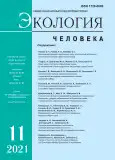ENVIRONMENTAL MONITORING USING ADOLESCENTS’ SALIVA IN OMSK
- 作者: Sarf E.A.1, Dergacheva M.V.1, Zharkikh L.A.1, Bel'skaya L.V.1
-
隶属关系:
- Omsk State Pedagogical University
- 期: 卷 28, 编号 11 (2021)
- 页面: 12-19
- 栏目: Articles
- URL: https://journals.rcsi.science/1728-0869/article/view/89912
- DOI: https://doi.org/10.33396/1728-0869-2021-11-12-19
- ID: 89912
如何引用文章
全文:
详细
作者简介
E. Sarf
Omsk State Pedagogical University
M. Dergacheva
Omsk State Pedagogical University
L. Zharkikh
Omsk State Pedagogical University
L. Bel'skaya
Omsk State Pedagogical University
Email: ludab2005@mail.ru
кандидат химических наук, заведующая научно-исследовательской лаборатории биохимии
参考
- Бельская Л. В. Применение капиллярного электрофореза для определения минерального состава слюны человека // Бюллетень науки и практики. 2017. № 2. С. 132-140
- Бельская Л. В., Сарф Е. А., Косенок В. К. Биохимия слюны: методы исследования. Омск, 2015. 70 с
- Гаврилов В. Б., Бидула М. М., Фурманчук Д. А., Конев С. В., Алейникова О. В. Оценка интоксикации организма по нарушению баланса между накоплением и связыванием токсинов в плазме // Клиническая лабораторная диагностика. 1999. № 2. С. 13-17
- Гегерь Э. В., Золотникова Г. П. Оценка экологических рисков здоровью населения в районах, ранжированных по степени техногенного загрязнения // Экология человека. 2018. № 4. С. 10-15
- Доклад об экологической ситуации в Омской области за 2019 г. / Министерство природных ресурсов и экологии Омской области. Омск, 2020. 302 с
- Колесов С. А., Коркоташвили Л. В. Протеом слюны и его диагностические возможности // Клиническая лабораторная диагностика. 2015. № 5. С. 54-58
- Королюк М. А., Иванова Л. И., Майорова И. Г., Токарев В. Е. Метод определения активности каталазы // Лабораторное дело. 1988. № 1. С. 16-19
- Несмеянова Н. Н., Соседова Л. М. Состояние микроэкологии слизистых верхних дыхательных путей у подростков, проживающих в городах с химической промышленностью // Экология человека. 2015. № 4. С. 32-38
- Рембовский В. Р., Могиленкова Л. А., Радилов А. С., Савельева Е. И., Комбарова М. Ю. Перспективы биомониторинга для оценки здоровья при работах с опасными химическими веществами // Медицина экстремальных ситуаций. 2018. Т. 20, № 3. С. 398-407
- Семенова Н. В., Мадаева И. М., Даренская М. А., Колесникова Л. И. Процессы липопероксидации и система антиоксидантной зашиты у женщин в менопаузе в зависимости от этнической принадлежности // Экология человека. 2019. № 6. С. 30-38
- Соколов А. В., Костина Д. А., Мариничев С. С., Чаплыгин С. С., Колсанов А. В. Значимость определения нитритов в ротовой жидкости у здоровых людей // Клиническая лабораторная диагностика. 2018. Т. 63, № 4. С. 215-219
- Трофимчук А. А., Кабирова М. Ф., Гуляева О. А., Ларионова Т. К., Каримова Л. К., Саляхова Г. А. Уровень эссенциальных и токсичных элементов в биосредах полости рта у работников горно-обогатительного комбината, занятых добычей и переработкой медно-цинковых руд // Проблемы стоматологии. 2018. Т. 14, № 1. С. 33-36
- Федотова Т. А., Кушнир С. М., Антонова Л. К., Усова Е. В. Микро- и макроэлементный состав слюны у часто болеющих детей, проживающих в различных экологически неблагоприятных условиях // Российский вестник перинатологии и педиатрии. 2012. № 6. С. 74-77
- Ямбулатов А. М., Устинова О. Ю. Нарушение баланса витаминов у детей дошкольного возраста в условиях комплексного воздействия техногенных химических факторов // Здоровье населения и среда обитания. 2018. № 7 (304). С. 12-18
- Bel’skaya L. V, Kosenok V. K., Massard G. Endogenous Intoxication and Saliva Lipid Peroxidation in Patients with Lung Cancer. Diagnostics. 2016, 6 (4), pp. 39.
- Bel’skaya L. V., Kosenok V. K., Sarf E. A. Chronophysiological features of the normal mineral composition of human saliva. Archives of Oral Biology. 2017, 82, pp. 286292.
- Gegotek A., Niklinski J., Zarkovie N., Zarkovie K., Waeg G., Luczaj W., Charkiewiez R., Skrzydlewska E. Lipid mediators involved in the oxidative stress and antioxidant defense of human lung cancer cells. Redox Biology. 2016, 9, pp. 210-219.
- Le S., Josse J., Husson F. FactoMineR: An R Package for Multivariate Analysis. Journal of Statistical Software. 2008, 25 (1), pp. 1-18.
- Miller C. S., Foley J. D., Bailey A. L., Campell C. L., Humphries R. L., Christodoulides N., Floriano P. N. Current developments in salivary diagnostics. Biomark. Med. 2010, 4 (1), pp. 171-89.
- Morry J., Ngamcherdtrakul W., Yantasee W Oxidative stress in cancer and fibrosis: Opportunity for therapeutic intervention with antioxidant compounds, enzymes and nanoparticles. Redox Biology. 2017, 11, pp. 240-253.
- Nunes L. A., Mussavira S., Bindhu O. S. Clinical and diagnostic utility of saliva as a non-invasive diagnostic fluid: a systematic review. Biochemia Medica. 2015, 25 (2), pp. 177-92.
- Roblegg E., Coughran A., Sirjani D. Saliva: An allrounder of our body. European Journal of Pharmaceutics and Biopharmaceutics. 2019, 142, pp. 133-141.
- Rodrigues V. P., Franco M. M., Marques C. P., de Carvalho R. C., Leite S. A., Pereira A. L., Benatti B. B. Salivary levels of calcium, phosphorus, potassium, albumin and correlation with serum biomarkers in hemodialysis patients. Archives of Oral Biology. 2016, 62, pp. 58-63.
补充文件







